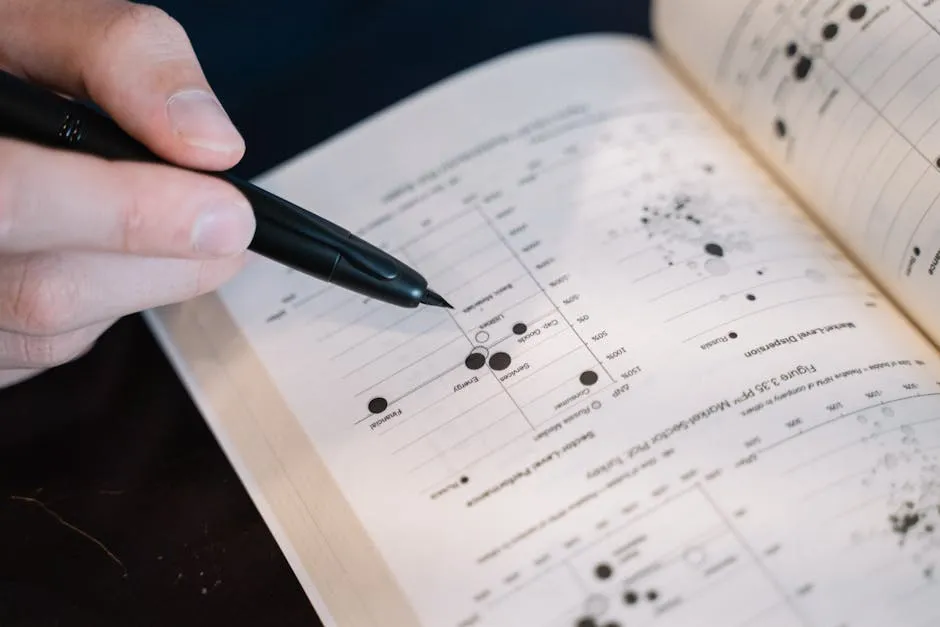Introduction
In today’s digital landscape, data analysis is crucial in economics and statistics. It’s the art of transforming raw data into insightful information, guiding decisions that can impact economies and organizations. For economics and statistics students, mastering data analysis techniques is essential for academic success and real-world application.
The purpose of this article is to explore various data analysis techniques vital for students in these fields. From regression analysis to time series analysis, these methods provide the tools to interpret data effectively. With these skills, students can navigate the complexities of economic data and statistical inference.
Data literacy is becoming increasingly valuable in the job market, especially within the finance and economics sectors. Employers seek graduates who can analyze data, generate insights, and make data-driven decisions. By honing data analysis skills, students position themselves as attractive candidates for future roles in various industries, from finance to public policy.
Ready to dive into the world of data analysis? Let’s explore how these techniques can empower students in their academic and professional journeys.

Understanding Data Analysis
What is Data Analysis?
Data analysis is a systematic approach to interpreting raw data. It involves inspecting, cleaning, transforming, and modeling data to uncover meaningful insights. In economics and statistics, data analysis is paramount for making informed decisions. It allows economists to test hypotheses, evaluate policies, and forecast future trends.
Types of Data
Data can be categorized into two types: quantitative and qualitative.
Quantitative Data is numerical and measurable. It includes figures like sales numbers, GDP growth rates, or temperature readings. This type of data is essential for statistical analysis, as it allows for precise calculations and predictions.
Qualitative Data, on the other hand, is descriptive and non-numerical. It encompasses categories like customer satisfaction, opinions, or behavioral observations. While qualitative data is harder to quantify, it offers valuable insights into human behavior and societal trends.
Understanding the differences between these data types is crucial for selecting appropriate analysis techniques. Each type requires specific methodologies and tools, making familiarity with both essential for students in economics and statistics. Armed with this knowledge, students can confidently tackle various data challenges in their academic pursuits.

Key Concepts in Data Analysis
Big Data, Metadata, and Real-Time Data: Big data refers to massive datasets that traditional data processing software can’t easily handle. It’s characterized by its volume, velocity, and variety. In economics, big data is vital for analyzing trends and making informed decisions. Metadata, on the other hand, is data about data. It helps to organize and understand the context of the actual data, making it easier for economists to interpret complex datasets. Real-time data is information that is available immediately upon collection. This kind of data is particularly crucial in finance and economics, where timely insights can lead to better decision-making.
If you want to get into the nitty-gritty of data analysis, I highly recommend picking up R Programming for Data Science. This book breaks down complex concepts into bite-sized pieces, making it perfect for beginners and seasoned analysts alike. You’ll be amazed at how quickly you can start applying R to your own projects!

Essential Data Analysis Techniques
Regression Analysis
Regression analysis is a statistical method used to assess the relationship between variables. Essentially, it helps identify how changes in one variable affect another. For instance, in economics, regression can show how advertising spend influences sales.
There are several types of regression analysis:
- Simple Regression: Involves one dependent variable and one independent variable. It’s like a first date—just two parties figuring each other out.
- Multiple Regression: Involves one dependent variable and multiple independent variables. Think of it as a group project where everyone contributes differently but aims for the same goal.
- Logistic Regression: This type is used when the outcome is binary (e.g., yes or no). It’s like choosing between pizza or sushi for dinner—there’s no middle ground!
In practical applications, regression analysis can help economists predict sales based on advertising spend, allowing businesses to allocate their budgets more effectively. For those looking to dive deeper into regression techniques, I suggest checking out Data Analysis Using Regression and Multilevel/Hierarchical Models. It’s a fantastic resource for mastering these methods.

Time Series Analysis
Time series analysis involves collecting data points over time to identify trends and patterns. This technique is essential in economics for understanding how variables change over time.
For example, economists use time series analysis to forecast GDP growth based on historical data. By examining past trends, they can make informed predictions about future economic conditions. This method is like following a stock’s historical performance to predict future behavior. If you’re interested in mastering this technique, consider picking up Python for Data Analysis. It covers powerful libraries that make time series forecasting a breeze!
In summary, both regression and time series analyses are crucial tools for economics and statistics students. They enable a deeper understanding of relationships between variables and provide insights that drive informed decision-making.

Cluster and Cohort Analysis
Cluster Analysis is a statistical technique used to group data points into clusters based on their similarities. Think of it like sorting your sock drawer—who needs that chaos? By segmenting data, researchers can identify patterns, trends, and relationships that might otherwise remain hidden. For example, in marketing, businesses can segment customers into distinct groups based on purchasing behavior. This allows for targeted marketing strategies. Imagine sending personalized promotions to customers who love hiking gear versus those who are into gourmet cooking. It’s all about relevance!
Cohort Analysis takes a different approach by tracking behavioral patterns of specific groups over time. This method is particularly useful in understanding how different segments react to changes. For instance, in economics, a cohort of consumers might be observed to see how their spending habits shift after a major economic event, like a recession. Companies can apply this technique in marketing to analyze customer retention rates and lifetime value. By understanding how different cohorts behave, businesses can tailor their strategies to enhance customer loyalty and drive sales growth. It’s like keeping tabs on your friends’ habits to improve your hangout plans!

Factor Analysis
Factor Analysis is a statistical method used to identify underlying relationships between variables. Imagine you’re trying to understand what influences consumer satisfaction. You might gather data on various aspects like price, quality, and customer service. Factor analysis helps distill this information into key factors, revealing that, perhaps, quality and customer service are the biggest influencers. This technique simplifies your data analysis, making it easier to interpret complex datasets.
In economics, factor analysis is particularly valuable in consumer behavior studies. For instance, researchers might use it to identify factors that drive purchasing decisions among different demographics. By understanding these factors, businesses can tailor their marketing strategies more effectively. If quality and price are the dominant factors for a certain age group, companies can adjust their messaging accordingly. This method allows for a more nuanced understanding of consumer preferences, leading to smarter business decisions. If you want to understand the broader implications of these factors, grab a copy of The Data Science Handbook for comprehensive insights!

Monte Carlo Simulations
Monte Carlo Simulations are a sophisticated statistical technique used to model the probability of different outcomes in uncertain situations. Picture yourself tossing a coin repeatedly to predict whether it’s more likely to land heads or tails. Now scale that up to complex financial models! By running simulations thousands of times, analysts can estimate the range of possible outcomes and their probabilities. This helps in assessing risks and making informed decisions.
In economics, Monte Carlo simulations are often applied in risk assessment and decision-making under uncertainty. For example, an investor might use these simulations to predict the potential returns of a portfolio based on historical market data. By understanding the likelihood of various outcomes, investors can strategize more effectively, weighing potential risks against expected returns. It’s like playing the odds in a game of poker but with data instead of cards. This technique empowers economists and financial analysts to navigate the unpredictable waters of markets with greater confidence. If you’re intrigued by these simulations, check out Data Science for Dummies for a great overview!

The Data Analysis Process
Data analysis is not just a buzzword; it’s the backbone of informed decision-making in economics and statistics. Understanding the steps involved in data analysis can empower students to tackle real-world problems with confidence.
Steps in Data Analysis
- Define the Question: It’s crucial to clarify what you’re trying to find out. A well-defined question sets the stage for effective analysis. For instance, instead of asking, “What affects sales?” specify, “How does advertising spending impact quarterly sales?” This clarity helps in focusing your efforts.
- Collect Data: Once you have your question, it’s time to gather data. Data can come from various sources: surveys, government databases, or even scraping data from websites. Ensure the data is relevant and reliable. Quality data is essential for meaningful insights.
- Clean the Data: Cleaning your data is like preparing your ingredients before cooking. Remove duplicates, handle missing values, and correct inaccuracies. This step ensures your analysis is based on accurate information. A clean dataset minimizes errors and enhances the reliability of your results.
- Analyze the Data: Now comes the fun part—analyzing! Choose the right analytical methods based on your research question. Techniques could range from regression analysis to time series analysis, depending on what you’re trying to uncover. Each method offers unique insights and helps illuminate different aspects of your data.
- Visualize and Share Findings: Finally, make your findings accessible. Data visualization tools like Tableau and Power BI can transform complex data into understandable graphics. Visualizations not only highlight trends but also make your insights more impactful and engaging. Share your findings through reports or presentations to encourage discussion and further exploration.

Tools for Data Analysis
When it comes to data analysis, the right tools can make all the difference. Here’s a look at some popular options for economics and statistics students.
- R: A powerhouse for statistical analysis, R offers diverse packages for various data analysis needs. With a supportive community, students can find resources easily. It’s great for those who enjoy coding and want to dive deep into statistical modeling.
- Python: Known for its versatility, Python is excellent for data manipulation and analysis. With libraries like Pandas and NumPy, it allows for efficient data handling. Additionally, Python’s visualization libraries like Matplotlib and Seaborn make it easy to present findings.
- Excel: Don’t underestimate the power of Excel! It’s user-friendly and widely used for basic data analysis. Excel’s functions and pivot tables allow for quick calculations and visualizations. It’s an excellent starting point for beginners or for those handling smaller datasets. For those looking to master Excel, grab a copy of Excel 2019 for Dummies!
- Tableau and Power BI: These tools excel in data visualization. They allow users to create interactive dashboards and share insights effortlessly. For students aiming to present their findings in a visually appealing manner, mastering these tools is beneficial.
- Stata: Particularly popular in economics, Stata is tailored for data management and statistical analysis. Its user-friendly interface makes it a favorite among students who want to perform econometric analyses without extensive programming knowledge. If you want to get started with Stata, consider Stata: A Practical Introduction.

Comparative Analysis
Each tool has its strengths and weaknesses. R and Python offer powerful analytical capabilities but require coding skills. Excel, while more accessible, may not handle large datasets as efficiently as R or Python. Tableau and Power BI shine in visualization but may lack the depth of analysis provided by programming languages. Ultimately, the choice of tool depends on the specific needs of the analysis, the dataset size, and the user’s comfort level with software. By understanding these tools, students can choose the right one to enhance their data analysis projects.
By following these steps and utilizing the right tools, students can master the art of data analysis, making them valuable assets in any analytical environment.

Applications of Data Analysis in Economics
Data analysis plays a pivotal role in economics, helping to transform raw figures into actionable insights. Let’s take a look at some real-world case studies that demonstrate the practical applications of various data analysis techniques in economic contexts.
Case Studies
- Housing Market Analysis in California: In California, researchers used regression analysis to examine the relationship between housing prices and various economic factors. The study analyzed data from over two decades, focusing on variables like interest rates, income levels, and employment rates. The findings revealed a strong correlation between low-interest rates and increased housing demand. Consequently, policymakers adjusted housing regulations to align with these insights, aiming to stabilize the market and prevent future housing bubbles. This case exemplifies how regression analysis can guide critical economic policies.
- Unemployment Rate Forecasting: A prominent economic research institute employed time series analysis to forecast unemployment rates in the United States. Utilizing historical data spanning thirty years, the researchers identified trends and seasonal patterns in unemployment rates. By applying advanced forecasting methods, they predicted a rise in unemployment due to impending economic downturns. This information was pivotal for government agencies, prompting preemptive measures to mitigate the impact on job seekers. This case illustrates the importance of time series analysis in predicting economic trends.
- Consumer Behavior in Retail: A retail company conducted cohort analysis to understand consumer purchasing behavior over time. By segmenting customers based on their first purchase date, the company tracked their spending habits across different seasons and promotions. The results showed that certain cohorts responded positively to holiday marketing campaigns, leading to a spike in sales. Armed with this knowledge, the retail company tailored its marketing strategies for specific customer segments, significantly boosting revenue. This case highlights the power of cohort analysis in driving business decisions.
- Economic Impact of COVID-19: During the COVID-19 pandemic, many economists turned to Monte Carlo simulations to assess the potential economic impact of various lockdown measures. By simulating different scenarios with varying degrees of restrictions, researchers estimated the possible outcomes for GDP contraction and recovery. These insights were crucial for governments worldwide, informing them on which measures would balance public health with economic stability. This case showcases how Monte Carlo simulations can enhance understanding of complex economic scenarios.
- Inflation Predictions in Greece: In Greece, a team of economists used factor analysis to identify key drivers behind inflation rates. By analyzing various economic indicators such as consumer price indexes and wage growth, they distilled the data into essential factors influencing inflation. The results underscored that wage growth was a significant predictor of inflation, prompting the government to reconsider wage policies to maintain economic equilibrium. This application of factor analysis demonstrates its utility in informing economic policy decisions.

These case studies underscore the significance of employing data analysis techniques in economics. By leveraging methods like regression analysis, time series analysis, cohort analysis, Monte Carlo simulations, and factor analysis, economists can derive valuable insights that shape policies and business strategies. The implications of these findings are not only academic; they can profoundly influence decision-making processes at various levels of the economy.
Conclusion
Data analysis techniques are vital for economics and statistics students. They empower students to interpret complex datasets, enabling informed decisions in academic and professional contexts.
Summary of Key Points: Data analysis techniques, such as regression analysis and time series analysis, are essential tools for understanding economic phenomena. They help students navigate the complexities of data and make sense of trends and relationships. Mastering these techniques enhances students’ problem-solving skills and prepares them for diverse roles in economics.
Future Outlook: The landscape of data analysis is evolving rapidly. As technology advances, new tools and methods will emerge, making data analysis even more integral to economics education. Students must stay updated on these developments to remain competitive in the job market. Data literacy will continue to be a sought-after skill, with employers valuing graduates who can analyze and interpret data effectively.
Call to Action: Economics and statistics students should actively develop their data analysis skills. Engage in coursework, participate in projects, and seek internships that offer practical experience. The more exposure you gain, the better equipped you’ll be to tackle real-world challenges in your future career. Embrace the world of data analysis, and watch as it opens doors to exciting opportunities!
FAQs
What are the most important data analysis techniques for economics students?
Key techniques include regression analysis, time series analysis, cluster analysis, and Monte Carlo simulations. Each method serves a unique purpose, helping to uncover relationships between variables and forecast economic trends.
How can students improve their data analysis skills?
Students can enhance their skills by enrolling in online courses, attending workshops, and engaging in practical projects. Utilizing resources like textbooks and online tutorials can also provide valuable insights into data analysis methods.
Why is data analysis important for economists?
Data analysis is crucial for making informed decisions and policy recommendations. Economists rely on data to test hypotheses, evaluate the effectiveness of policies, and predict future trends, ultimately guiding better strategic choices.
What tools are essential for data analysis in economics?
Essential tools include R, Python, Excel, and statistical software like Stata. These tools facilitate data manipulation, statistical modeling, and visualization, enabling economists to analyze and interpret data efficiently.
Please let us know what you think about our content by leaving a comment down below!
Thank you for reading till here 🙂
For students considering their academic path, it’s worth exploring whether economics and statistics is a good double major.
When interpreting data, understanding the difference between inferential statistics and descriptive statistics can be crucial.
For those preparing for exams, having a solid grasp of the AP statistics formula sheet can be immensely helpful.
All images from Pexels




